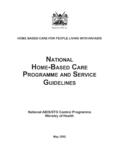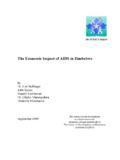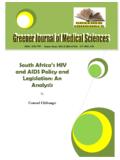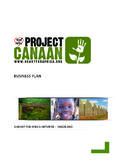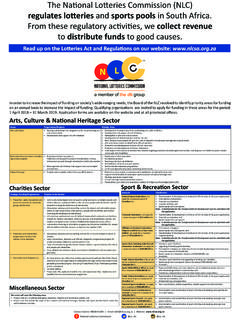Transcription of Policies for Orphans and Vulnerable Children - …
1 POLICYJuly 2003byRose SmartPolicies for Orphans andVulnerable Children :A Framework for Moving AheadPOLICYPOLICY is funded by the Agency for International Development (USAID) under Contract No. HRN-C-00-00-00006-00, beginning July 7, 2000. The project is implemented by the Futures Group Internationalin collaboration with the Centre for Development and Population Activities (CEDPA) and Research TriangleInstitute (RTI).ISBN 0-9605196-4-5A Framework for Moving AheadPolicies for Orphans andVulnerable Children :A Framework for Moving AheadPOLICYJuly 2003byRose SmartPolicies for Orphans and Vulnerable 1 Purpose of the PaperFocusTarget ReadershipMethodologyConcepts and Definitions .. 3 Definition of a ChildDefinition of an OrphanDefinition of a Child Orphaned by HIV/AIDST erminology and Concepts Relating to Orphans and Children Affected by HIV/AIDSS cale and Impact.
2 7 Legal and Policy Frameworks for OVC Responses .. 9 International and National Legal and Policy InstrumentsFrameworks for Responding to the Issue of OVCP rinciples to Guide ResponsesA Decade of OVC-related Events .. 13 Current Responses and Policy Gaps .. 14 Proposed OVC Policy PackageConclusion .. 23 Endnotes .. 24 References .. 26iiA Framework for Moving AheadAcknowledgmentsThanks to all who contributed ideas and comments on thepaper, in particular, Don Dickerson, Norine Jewell, KevinOsborne, and Brenda Rakama from the POLICY are also due to POLICY s overseas staff whoresearched the situation of Orphans and Vulnerable childrenin their respective countries and completed the questionnairesthat provided valuable information and insights regardingpolicy would also like to extend our appreciation to LindaSussman from the Agency for InternationalDevelopment s (USAID)
3 Office of HIV/AIDS and RoseiiiMcCullough from USAID s Office of Population andReproductive Health for their helpful comments andtechnical review. And, finally, sincere thanks to PeterMcDermott of USAID s Africa Bureau for creating anopportunity for the POLICY consultant to attend the 2002 Eastern and Southern Africa Workshop on Orphans andVulnerable Children in Windhoek, Namibia, convened views expressed in this paper, however, do notnecessarily reflect those of for Orphans and Vulnerable ChildrenivA Framework for Moving AheadIntroduction The Children of the world are innocent, Vulnerable ,and dependent. They are also curious, active, and fullof hope. Their time should be one of joy and peace, ofplaying, learning, and growing.
4 Their future shouldbe shaped in harmony and co-operation. Their livesshould mature, as they broaden their perspectives andgain new experiences. World Declaration on the Survival,Protection, and Development of ChildrenSeptember 30, 1990 The HIV/AIDS epidemic is shattering Children s lives andreversing many hard won Children s rights gains. Followingmore than a decade of inadequate action, there is now anabsolute imperative that the global community and everyindividual nation urgently mount large-scale, multifacetedresponses to secure the future of all Orphans and vulnerablechildren (OVC).Purpose of the PaperThe paper has four main objectives: To present a summary of the global OVC situationand current policy responses; To outline existing policy frameworks forresponding to OVC; To identify policy-level gaps in national responsesto the growing crisis of OVC; and To propose a country-level OVC policy package and recommendations for future policy dialogue paper has three explicit emphases.
5 First, a recognitionthat the overwhelming majority of OVC live in developingcountries, in particular in sub-Saharan Africa, and this istherefore the focus of the paper and the source of most ofthe examples that are cited. Second, an emphasis on HIV/AIDS affected Children (as opposed to infected Children ),while recognizing that many OVC may be both affected andinfected. And finally, a focus on the policy level, as opposedto the program or intervention level, though this distinctionis somewhat artificial and at times difficult to final focus means that the paper does not attempt topresent any of the implementation and service provisionchallenges that are currently in the public debate, such ashow to scale up responses and roll out successful pilotprojects.
6 In addition, the brief does not permit acomprehensive exploration of specific issues that have clearpolicy implications such as the dilemma of community-basedversus institutional care; the importance of includingpsychosocial support for OVC as part of comprehensive andholistic support; the critical need to vigorously address childsexual abuse; and the challenge of keeping infected parentsalive to reduce or delay orphanhood. These issues areadequately covered in other publications, as well as withinnational and international ReadershipThis paper is written primarily for individuals with strategicdecision-making responsibilities for HIV/AIDS programs,in general, and for OVC programs, specifically includingUSAID personnel (such as health and population officers inmissions), other donors, and program managers ingovernment and in civil society structures (such asnongovernmental organizations [NGOs] and faith-basedorganizations [FBOs]).
7 MethodologyThree main methodologies were used in preparing this paper:a literature review; an analysis of information provided byPOLICY Project offices in Benin, Cambodia, Haiti, Kenya,Nigeria, Uganda, and Zambia; and papers presented anddialogue with participants at the Eastern and Southern AfricaWorkshop on Orphans and Vulnerable Children held inWindhoek, Namibia, in November country-level information from POLICY Project staffwas provided in response to a questionnaire. Thequestionnaire covered the legal and policy environmentwithin countries related to both Children and HIV/AIDS,1 Policies for Orphans and Vulnerable ChildrenOVC definitions used in Policies , the forms of state support(if any) available for Children , and whether or not an OVCassessment had been done and if the results had been usedin defining appropriate responses.
8 Except for a couple ofinstances, most of the information provided in thequestionnaires concurred with other sources of Framework for Moving AheadConcepts and DefinitionsDefinition of a ChildIn most international and national instruments, Children aredefined as boys and girls up to the age of 18 years. The ageof 18 years relates primarily to the generally accepted ageof majority, though in all countries there are legal exceptions,for example, the age at which a child may be married, makea will, or consent to medical treatment. In South Africa, a child may consent to medicaltreatment, such as an HIV test, without parentalconsent from the age of 14 In Sri Lanka, Sri Lankan Kandyan and Muslim lawsregulate the minimum age for marriage.
9 Girls asyoung as 12 may be married with parental In Ethiopia,a minor may make a will alone when heattains the age of 15 the context of HIV/AIDS, the definition of a child hasparticular relevance in light of The age at which compulsory education ends; Any differences between girls and boys, forexample, in relation to marriage and the age of sexualconsent; Legal capacity to inherit and to conduct propertytransactions; and The ability to lodge complaints or seek redressbefore a court or other of an OrphanThe definition of an orphan varies from country to country(see Table 1). The main variables are Age Children up to 15 or up to 18 years; and Parental loss mother, father, or both parents of a Child Orphaned byHIV/AIDSThe report, Children on the Brink a joint publication ofUNAIDS, UNICEF, and USAID has become the standardreference for definitions and estimates related to OVC.
10 InChildren on the Brink 2002, the UNAIDS Reference Groupon Estimates, Modeling, and Projections10 defines a childorphaned by HIV/AIDS as a child, under 15 years of age,who has lost at least one parent to variables presented in the estimates of OVC include Orphans as a percentage of all Children ; Number and percentage of Children orphaned as aresult of HIV/AIDS as compared with total Orphans ;and A breakdown of Children who are maternal, paternal,or double 1. Definitions of Orphans from SelectedAfrican CountriesNamibiaA child under the age of 18 who haslost a mother, a father, or both or aprimary caregiver due to death, or achild who is in need of child less than 18 years of age whohas lost both parents, regardless ofhow they child below 18 years who has lostone (single parents) or two (marriedcouples) biological or child below the age of 18 years whohas lost one or both child who has lost one or for Orphans and Vulnerable ChildrenA frequently expressed concern about the definition used toquantify and predict numbers of Orphans is the age range of0 14.

